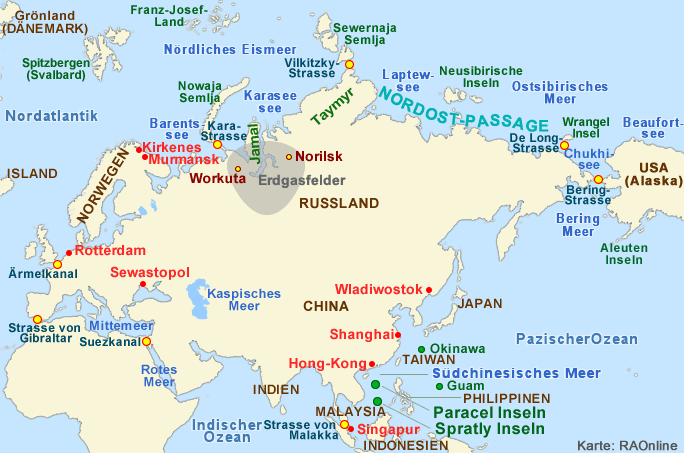 |
Arktis Hoher Norden |
 |
Arktis Hoher Norden Weitere Informationen |
|
|
Climate Change in the Arctic
|
 |
|
2010: Historic sea route opens through the Arctic to China
|
For the first time ever, a bulk carrier with non-Russian flag is using the Northern Sea Route as a transit trade lane, when transporting iron ore from the Northern part of Norway to China via Arctic and Russian waters. The historic transit is about one third shorter than traditional shipping routes and will save time, fuel and CO2 - as well as opening up new business opportunities for the mining and shipping industries. A strong Nordic-Russian partnership is behind this business adventure.
The international shipping indu stry will witness a historic event, when the vessel departs from the port of Kirkenes in Northern Norway in early September. One of the world's few modern heavy ice-class bulk carriers - MV NORDIC BARENTS - will carry a cargo of iron ore concentrate via the Northern Sea Route (NSR) through Arctic and Russian waters to China. The ship will load 41,000 tons before setting course for China. Tschudi Shipping Company through its subsidiary Tschudi Arctic Transit and Nordic Bulk Carriers, working with Russian maritime authorities, are the leading pioneers behind the Nordic-Russian partnership and the historic northern route.
"We are very excited about the opportunities the NSR will generate," says Felix H. Tschudi, Chairman of the Norwegian Tschudi Shipping Company and the largest shareholder of Northern Iron, the Australian ASX listed owner of the Sydvaranger iron ore mine. "It has been our ambition for years, so we are very happy to finally have the opportunity to do this voyage. The Northern Sea Route can be of great importance for the companies in northern Scandinavia and on the Kola Peninsula which ship oil, gas, minerals and other raw materials to the increasingly important Asian markets."
Strong business potential
The Northern Sea Route to China across the Arctic is shorter than routes through the Suez Canal. According to the partners, the route has the potential to generate significant savings for both cargo and ship owners, and in addition during this voyage there is no threat of piracy.
Managing director in Nordic Bulk, Christian Bonfils, explains. "The Northern Sea Route shortens the distance to China by about one third," he says. "This results in a significant reduction in fuel consumption and transportation time - and it also means much lower CO2 emissions. The fuels savings alone add up to approximately USD 180,000. Not only does this route open up opportunities for the mining industry, but also for Nordic Bulk Carriers; we are specialized in operating ice classed bulk carriers, and when we entered into a strategic cooperation with the owners of these specialized ships we quickly saw the unique potential of the ships. We are proud to be a partner in this project which emphasises our position as leading within this segment. "
Important cooperation with Russia
Russian authorities, the Northern Sea Route Administration under the Ministry of Transportation and Rosatomflot, the operator of the Russian national icebreaking fleet, have given the project their first-ever approval for a foreign flagged vessel to ship a cargo in transit from a foreign port to a foreign port through Russian waters.
"This is an historic moment. In addition to opening a shorter pathway to China, the route will further strengthen the good and important cooperation between the Nordic countries and Russia. We will hopefully see new shipping and trade opportunities in this very important region," says Kristin Omholt-Jensen, Managing Director of the Centre for High North Logistics (CHNL), an international non profit organisation focusing on developing transport solutions for the High North. CHNL which is co-sponsored by the Norwegian Ministry of Foreign Affairs has played an important role in facilitating the project. "An exciting and challenging aspect of the project has been the large number of parties involved to realise this first voyage including insurance companies, ship brokers and the trading company Prominvest which is buying the cargo from the mine and selling it to Chinese end users", says Kristin Omholt-Jensen
Russian icebreakers operated by Rosatomflot will escort MV NORDIC BARENTS on its journey.
Nordic navigation takes a historical step
The voyage across the Arctic opens another chapter in the proud tradition of Nordic navigation.
"We will follow the MV NORDIC BARENTS expedition closely and with great interest. In addition to the business potential of the Northern Sea Route, this expedition once again emphasizes the strength, quality and long history of the Nordic maritime traditions. We are of course also very proud that a Danish and a Norwegian company in close cooperation with the Russian authorities are the pioneers behind this voyage of discovery," says Jan Fritz Hansen, vice president of the Danish Shipowners' Association.
The trip across the Arctic is a challenging task that requires great experience and navigational skills. In cooperation with the Russians, the expedition will help build critical expertise and experience in navigating these demanding waters.
A unique vessel for a historical trip
It takes more than an average ship to sail the Northern Sea Route. In fact, there are only a few vessels which can handle the task.
"MV NORDIC BARENTS is a so called ice-class 1a ship," explains Christian Bonfils, managing director at Nordic Bulk, the ship's commercial operator. "This is the highest conventional ice-class, and it was the only ship classification that the Russian authorities would allow to perform this transit. We are pleased that parties from three traditional seafaring nations made the transit possible through extraordinary commitment from all involved parties especially Tschudi Shipping, CHNL and Rosatomflot."
The parties estimate that the Northern Sea Route will be open for transit voyages for two to four months per year during the early autumn.
 |
| Source: Text Tschudi Shipping Company, August 2010 |
top
| Links |
 |
 |
 |
Externe Links |
|



